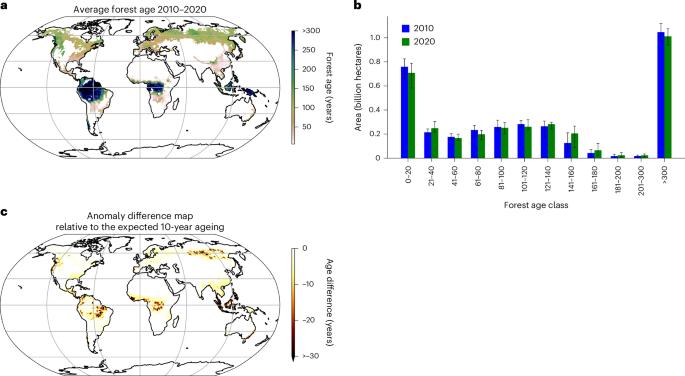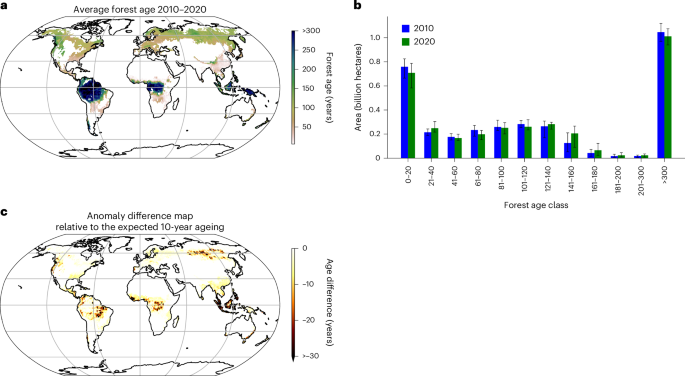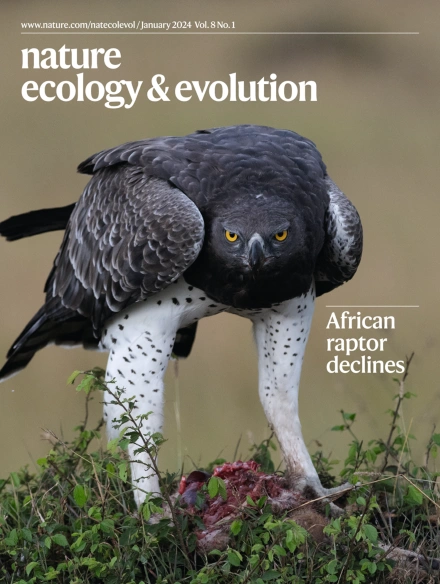林龄变迁与净碳平衡的全球共变。
IF 13.9
1区 生物学
Q1 ECOLOGY
引用次数: 0
摘要
森林年龄的转变对形成全球碳平衡至关重要,但其对碳储量和通量的影响仍然难以量化。在此,我们利用全球年龄测绘集成v2.0数据集,以及卫星衍生的地上碳(AGC)和大气反演衍生的净二氧化碳通量数据,分析了2010 - 2020年全球森林年龄动态。我们发现,亚马逊河流域、刚果盆地、东南亚和西伯利亚部分地区的森林年龄普遍下降,主要是由于林分更替的干扰,如火灾和采伐,导致老森林被新林分取代。与此同时,中国、欧洲和北美的森林经历了净老化。在全球范围内,林分更替导致了大量的AGC损失,老森林(100 - 200年,~98.0 MgC ha-1)向年轻的、碳贫乏的林分(-1)过渡,导致AGC净损失约0.14 PgC /年。尽管如此,在幼林替代率高的地区,由于这些幼林的快速再生,碳汇暂时增强。至关重要的是,这些年轻的森林不能弥补老森林的长期碳储存。我们的研究结果强调了保护老森林的重要性,同时优化森林管理战略,以最大限度地提高碳收益和加强气候减缓。本文章由计算机程序翻译,如有差异,请以英文原文为准。


Global covariation of forest age transitions with the net carbon balance
Forest age transitions are critical in shaping the global carbon balance, yet their influence on carbon stocks and fluxes remains poorly quantified. Here we analyse global forest age dynamics from 2010 to 2020 using the Global Age Mapping Integration v2.0 dataset, alongside satellite-derived aboveground carbon (AGC) and atmospheric inversion-derived net CO2 flux data. We reveal widespread declines in forest age across the Amazon, Congo Basin, Southeast Asia and parts of Siberia, primarily driven by stand-replacing disturbances such as fire and harvest, leading to the replacement of older forests by younger stands. Meanwhile, forests in China, Europe and North America experienced net ageing. Globally, stand replacement resulted in substantial AGC losses, with old forests (>200 years, ~98.0 MgC ha−1) transitioning to younger, carbon-poor stands (<20 years, ~43.5 MgC ha−1), leading to a net AGC loss of ~0.14 PgC per year. Despite this, regions with high rates of young stands replacing old forests exhibited a temporary strengthening of the carbon sink, driven by the rapid regrowth of these young stands. Crucially, these young forests do not compensate for the long-term carbon storage of old forests. Our findings underscore the importance of protecting old forests while optimizing forest management strategies to maximize carbon gains and enhance climate mitigation. A global analysis reveals regional trends of net forest ageing but also that widespread stand-replacing disturbances, such as fire and harvest, are driving declining forest age in many areas, often accompanied by substantial losses in aboveground carbon stocks and shifts in carbon sink dynamics.
求助全文
通过发布文献求助,成功后即可免费获取论文全文。
去求助
来源期刊

Nature ecology & evolution
Agricultural and Biological Sciences-Ecology, Evolution, Behavior and Systematics
CiteScore
22.20
自引率
2.40%
发文量
282
期刊介绍:
Nature Ecology & Evolution is interested in the full spectrum of ecological and evolutionary biology, encompassing approaches at the molecular, organismal, population, community and ecosystem levels, as well as relevant parts of the social sciences. Nature Ecology & Evolution provides a place where all researchers and policymakers interested in all aspects of life's diversity can come together to learn about the most accomplished and significant advances in the field and to discuss topical issues. An online-only monthly journal, our broad scope ensures that the research published reaches the widest possible audience of scientists.
 求助内容:
求助内容: 应助结果提醒方式:
应助结果提醒方式:


